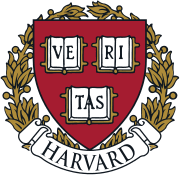Established
Harvard is the oldest institution of higher education in the United States, established in 1636 by vote of the Great and General Court of the Massachusetts Bay Colony.
Faculty
About 2,400 faculty members and more than 10,400 academic appointments in affiliated teaching hospitals
Students
- Harvard College: 6,699
- Graduate and professional students: 13,120
- Harvard Extension School: 16,193
- Total: 36,012 students
These numbers reflect student enrollment for the 2017–18 academic year.
School Color
| Crimson | PMS | CMYK | RGB | HEX |
 |
PMS 187U PMS 1807C |
C= 7 M= 94 Y= 65 K= 25 |
R= 165 G= 28 B= 48 |
A51C30 |
Alumni
More than 371,000 living alumni, over 279,000 in the U.S., and over 59,000 in some 202 other countries.
Honors
49 Nobel Laureates, 32 heads of state, 48 Pulitzer Prize winners
Motto
Veritas (Latin for “truth”)
Real Estate Holdings
5,457 acres
Library Collection
The Harvard Library—the largest academic library in the world—includes 20.4 million volumes, 180,000 serial titles, an estimated 400 million manuscript items, 10 million photographs, 124 million archived web pages, and 5.4 terabytes of born-digital archives and manuscripts. Access to this rich collection is provided by nearly 800 library staff members who operate more than 70 separate library units.
Museums
Harvard’s museums are stewards of more than 28 million works of art, artifacts, specimens, materials, and instruments. With deep roots in scholarship and teaching, these internationally renowned collections are fundamental to the development and continuation of many disciplines. These unparalleled institutions rank alongside some of the greatest museums in the world and they are open to the public. They welcome more than 650,000 local, national, and international visitors each year.
Faculties, Schools, and an Institute
Harvard University is made up of 11 principal academic units – ten faculties and the Radcliffe Institute for Advanced Study. The ten faculties oversee schools and divisions that offer courses and award academic degrees.
Undergraduate Cost And Financial Aid
Families with students on scholarship pay an average of $12,000 annually toward the cost of a Harvard education. Fifty-five percent of Harvard College students receive need-based scholarship aid, and the average grant this year is more than $53,000.
The Harvard College financial aid program requires no contribution from Harvard families with annual incomes below $65,000; asks from 0 to 10% of income for those with incomes up to $150,000; and expects proportionally more from families with incomes above $150,000.
Harvard College offers an easy-to-use net price calculator into which applicants and their families can enter their financial data to estimate the net price they will be expected to pay for a year at Harvard. Use the calculator to get an estimate the net cost of attendance in less than 5 minutes.
The total 2018-2019 cost of attending Harvard College without financial aid is $46,340 for tuition and $67,580 for tuition, room, board, and fees combined.
University Professors
The title of University Professor was created in 1935 to honor individuals whose groundbreaking work crosses the boundaries of multiple disciplines, allowing them to pursue research at any of Harvard’s Schools. View the list of University Professors.
Harvard University President
Lawrence S. Bacow is the 29th President of Harvard University.

This photograph is released under the Creative Commons Attribution 3.0 license by Harvard University.
University Income (Fiscal Year 2018)
$5.2 billion
University Expenses (Fiscal Year 2018)
$5.0 billion
Endowment (Fiscal Year 2018)
$39.2 billion
Harvard University Shields


2.gif)
.gif)
1.gif)
411.gif)










.gif)
















